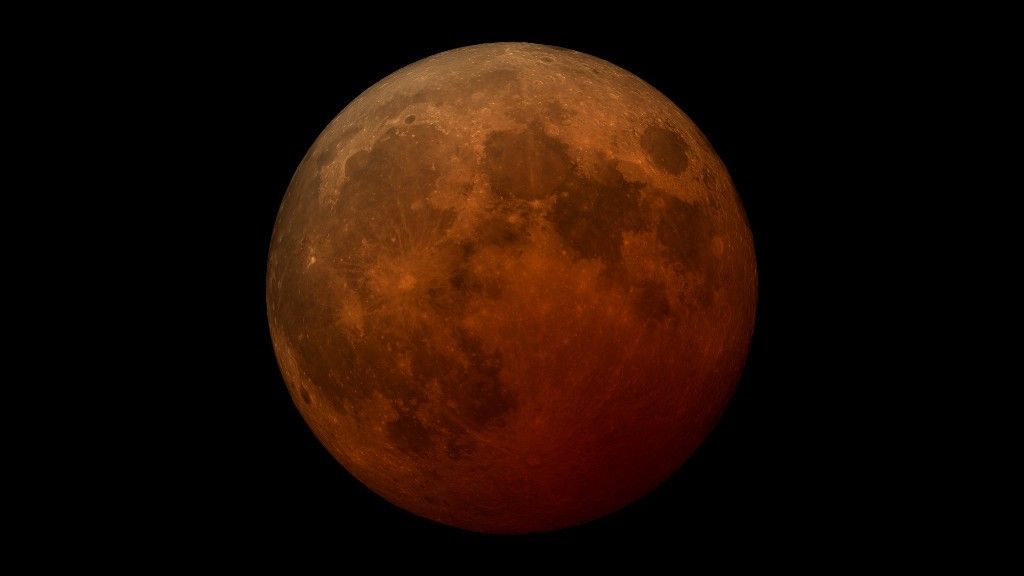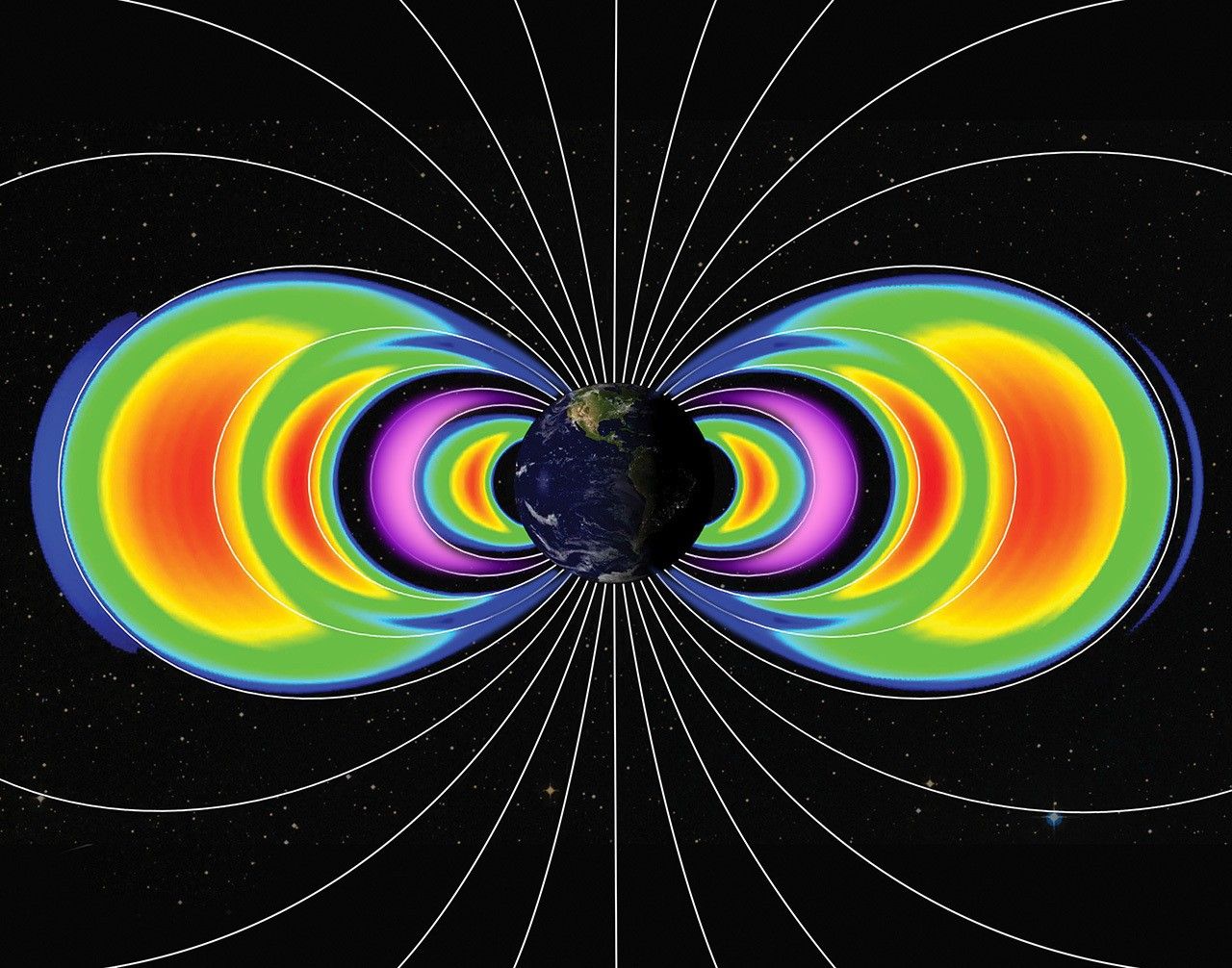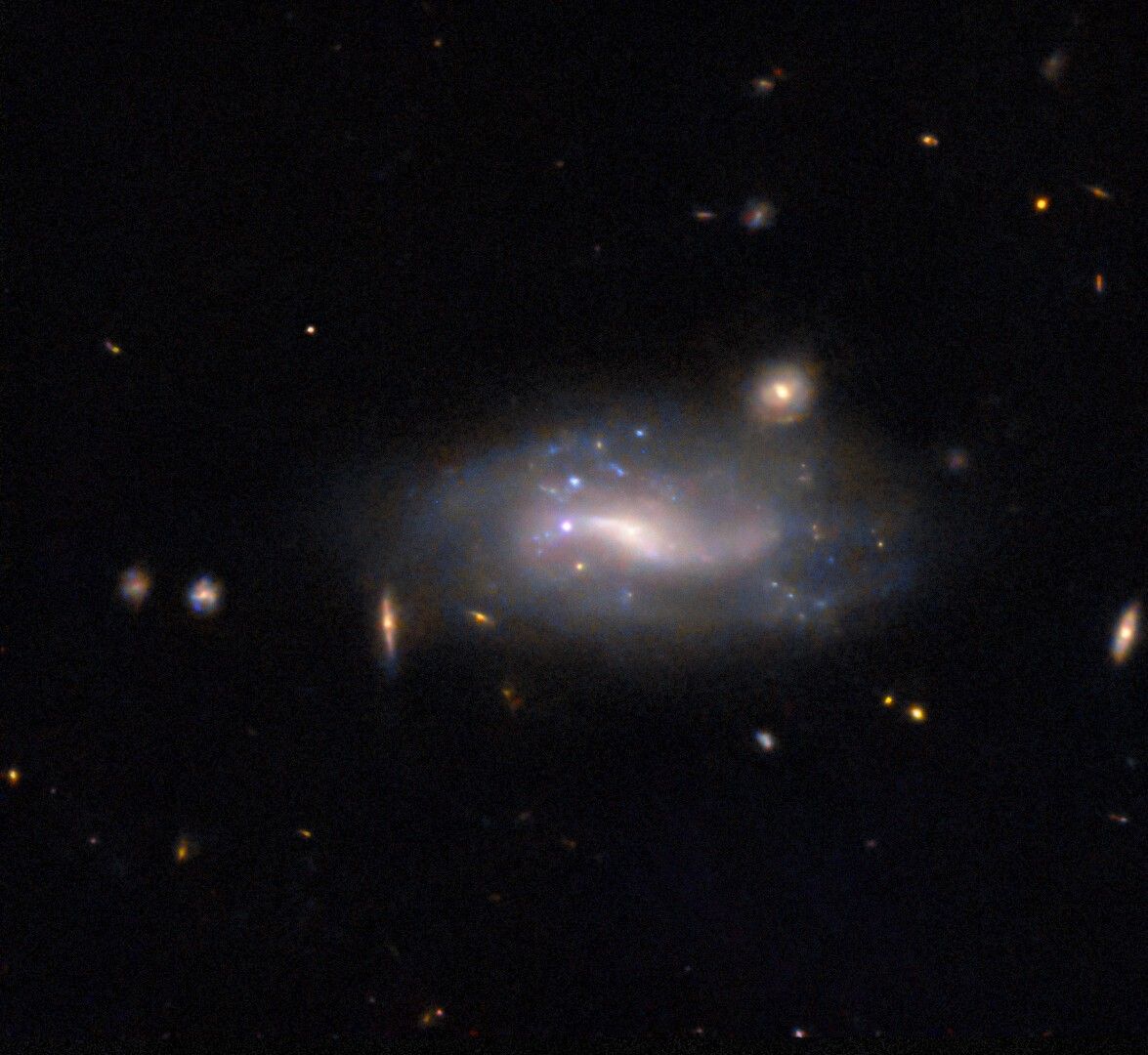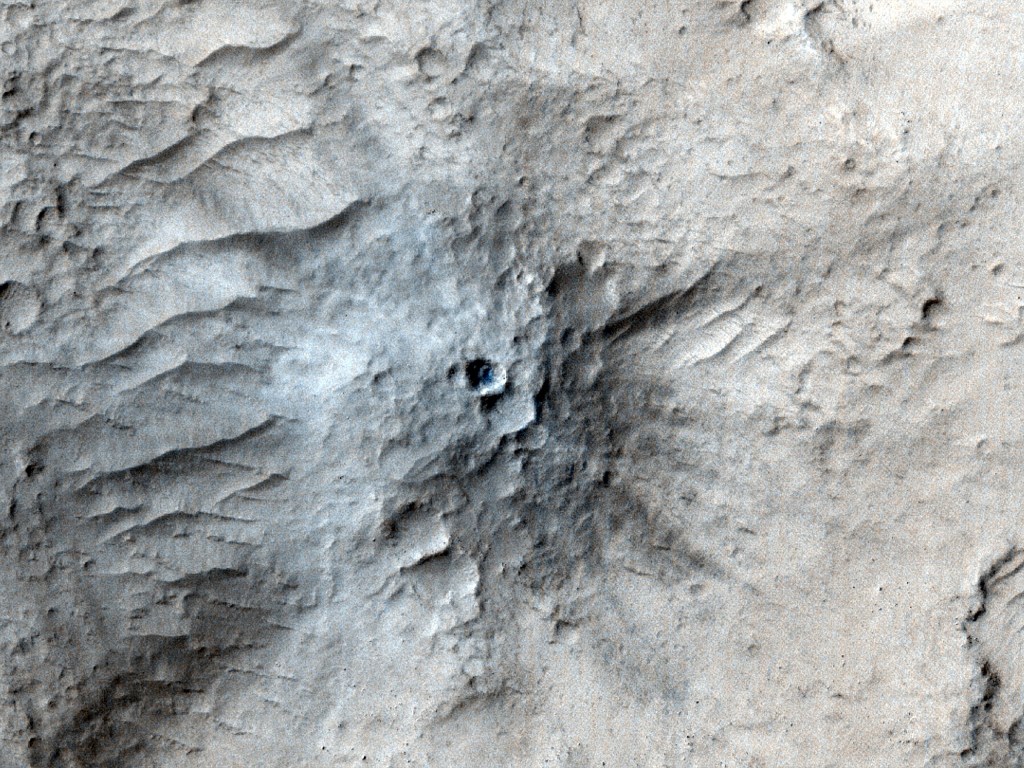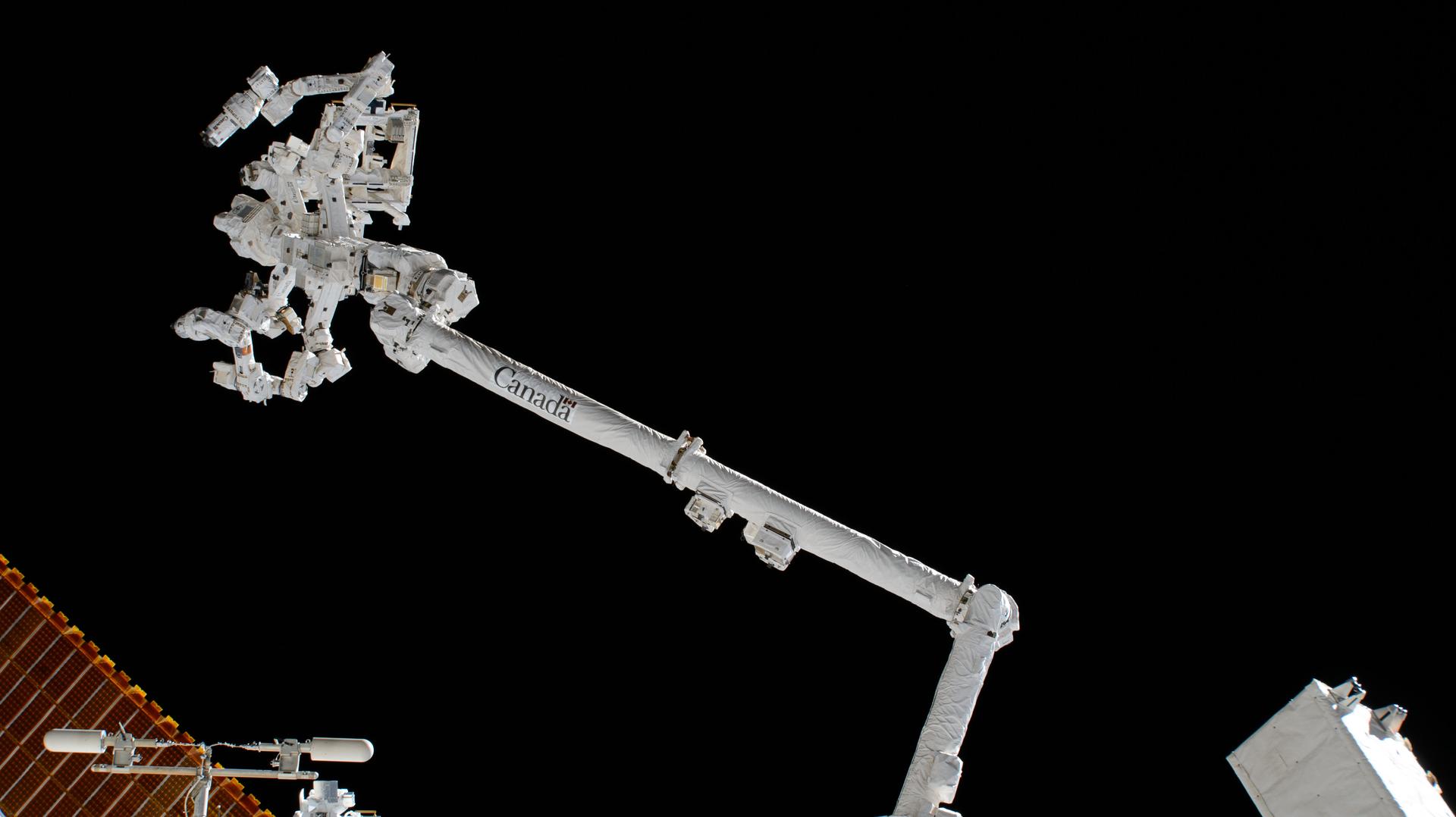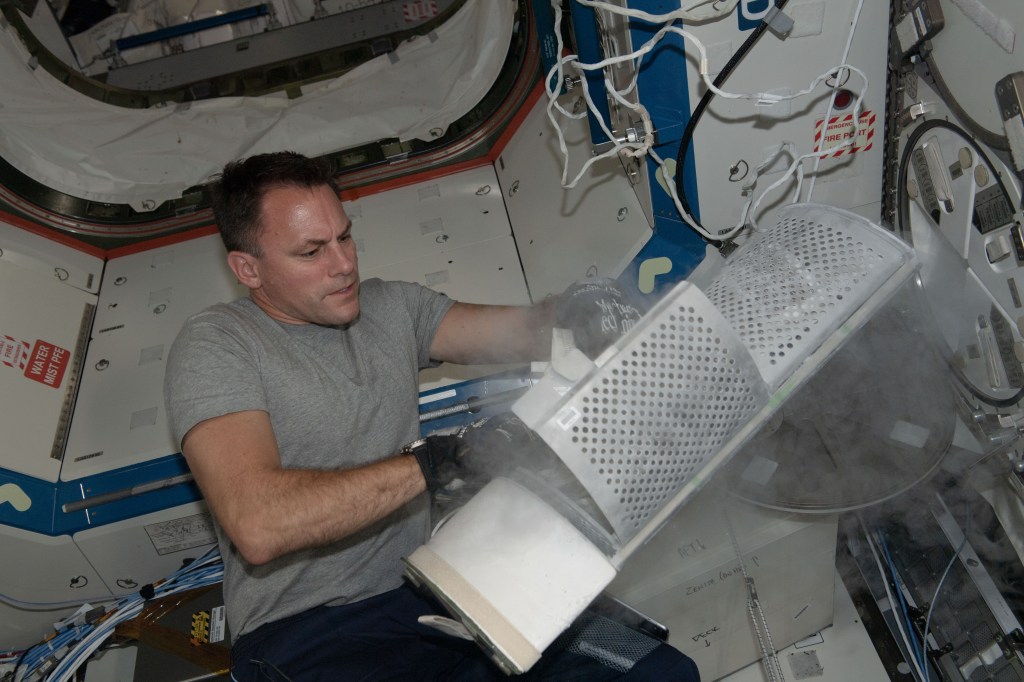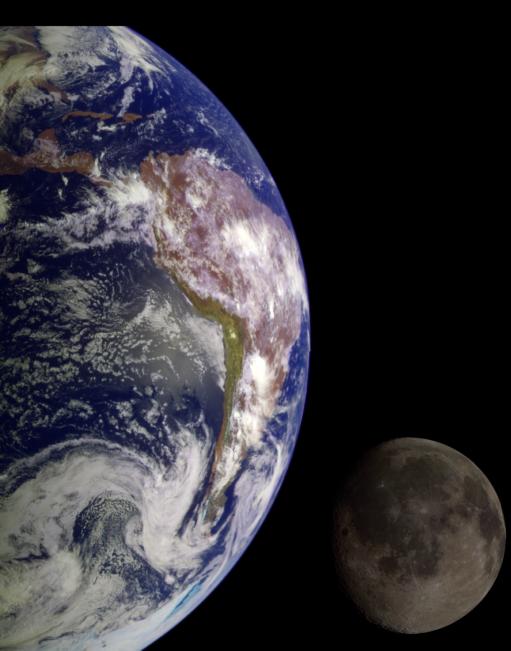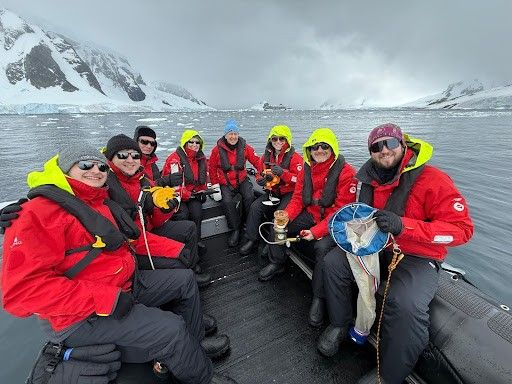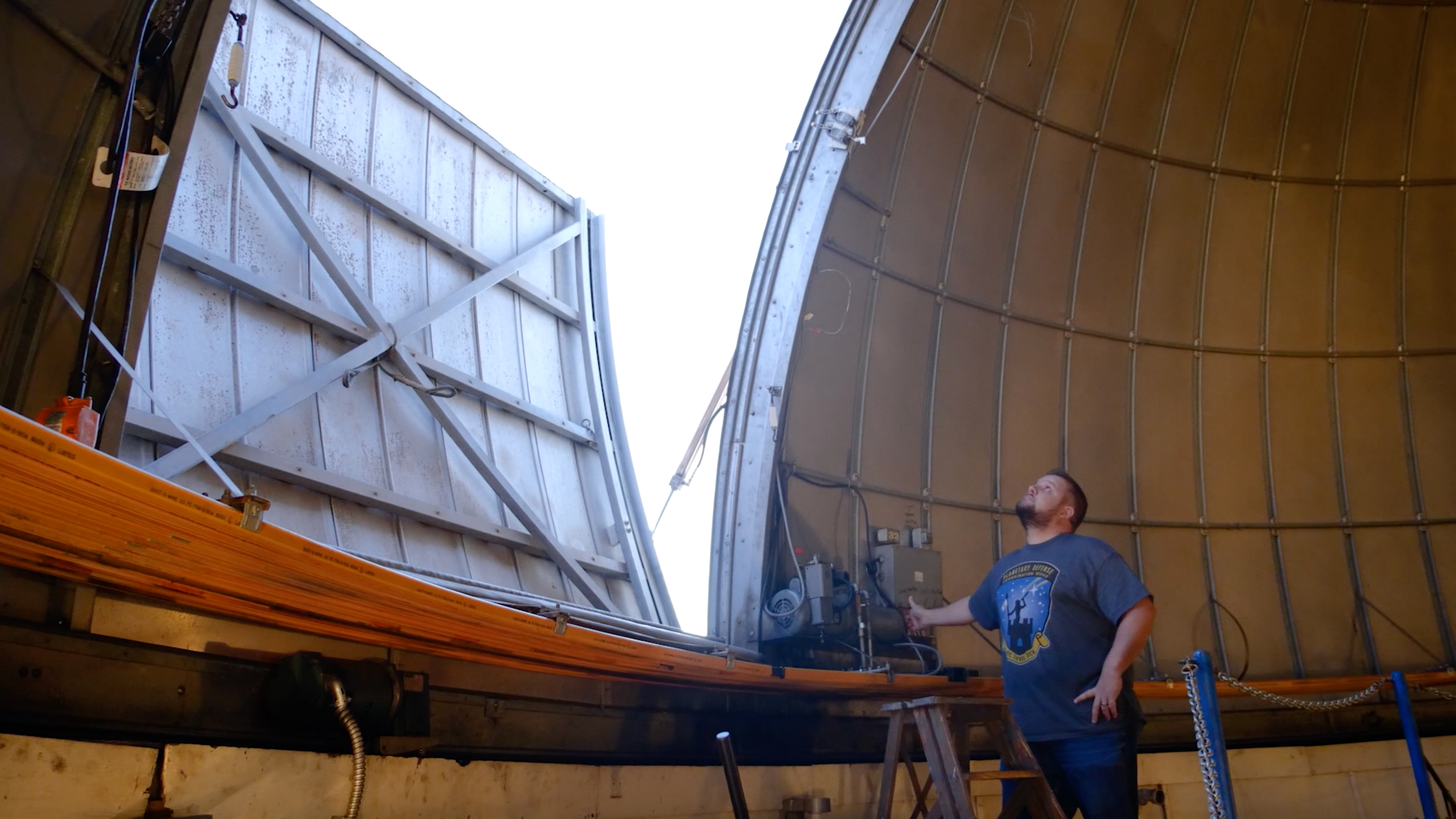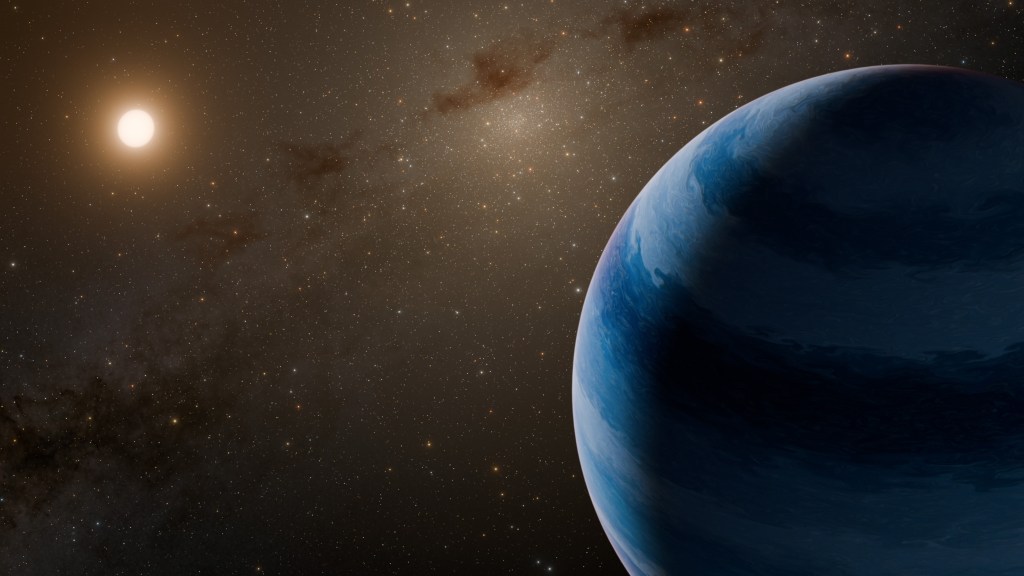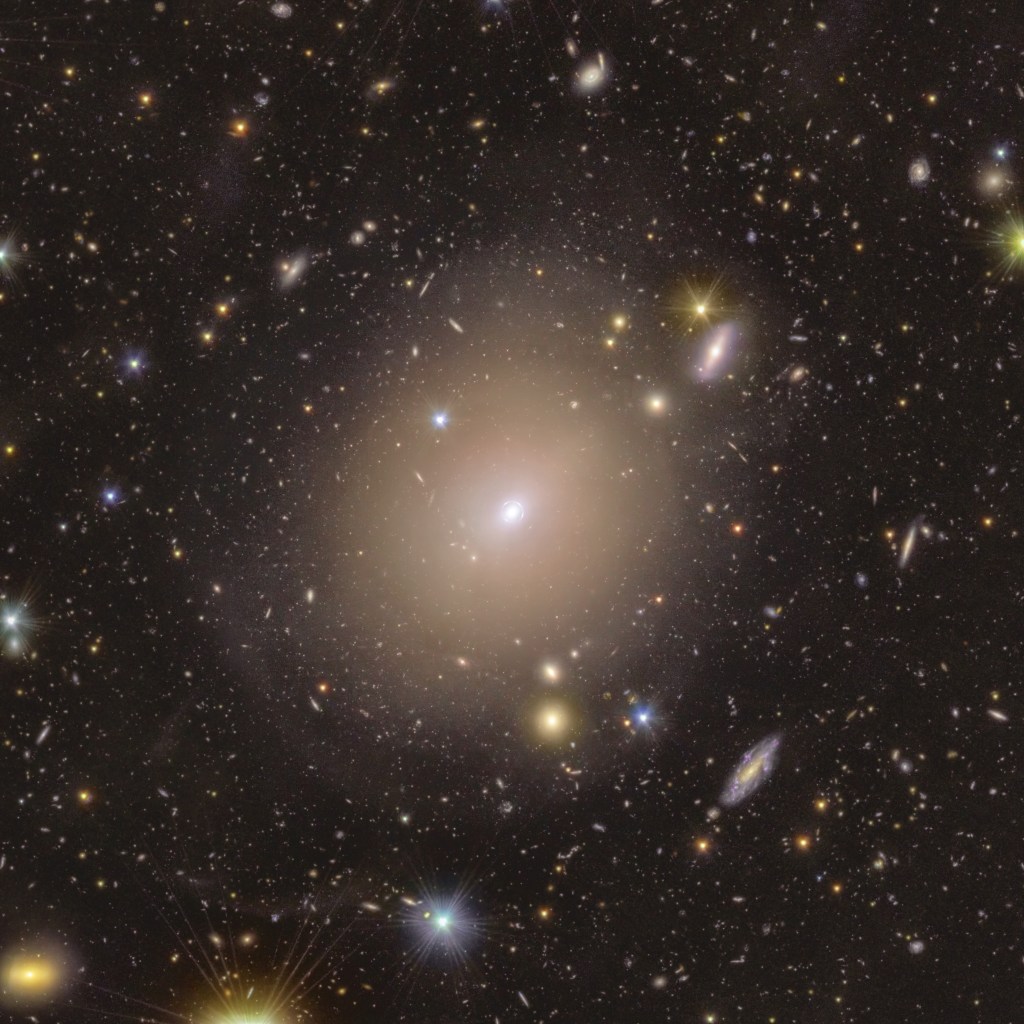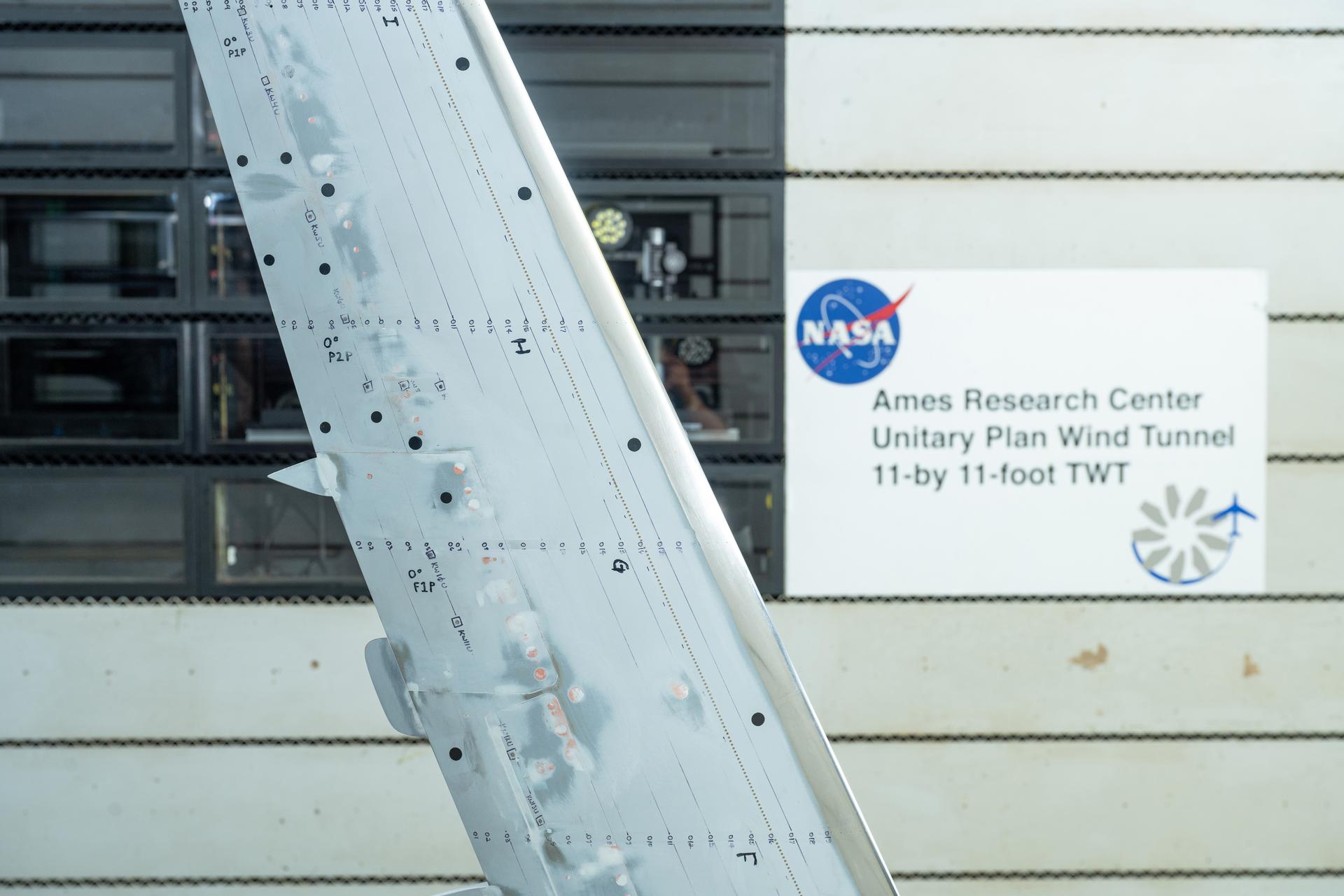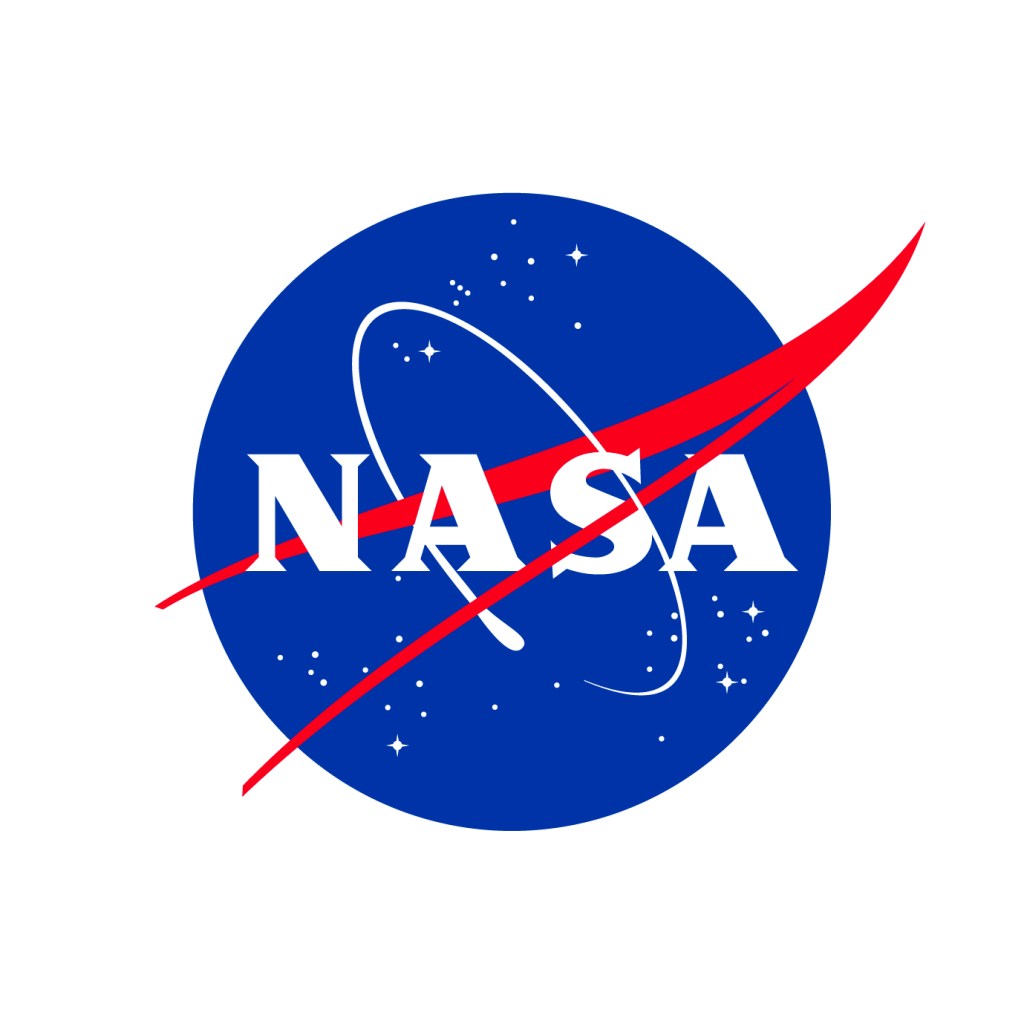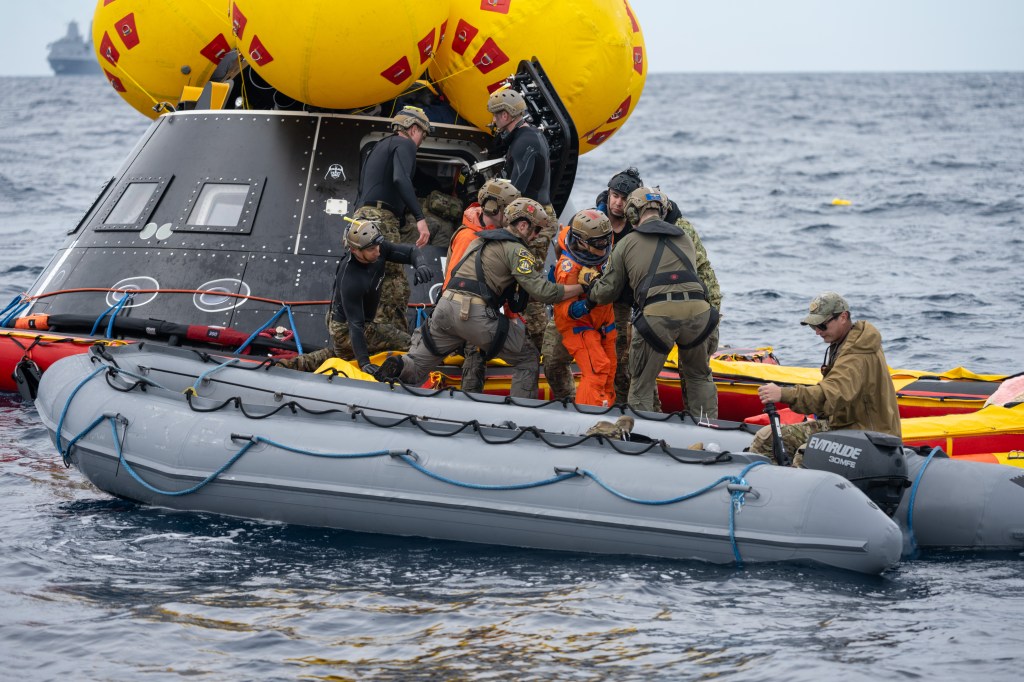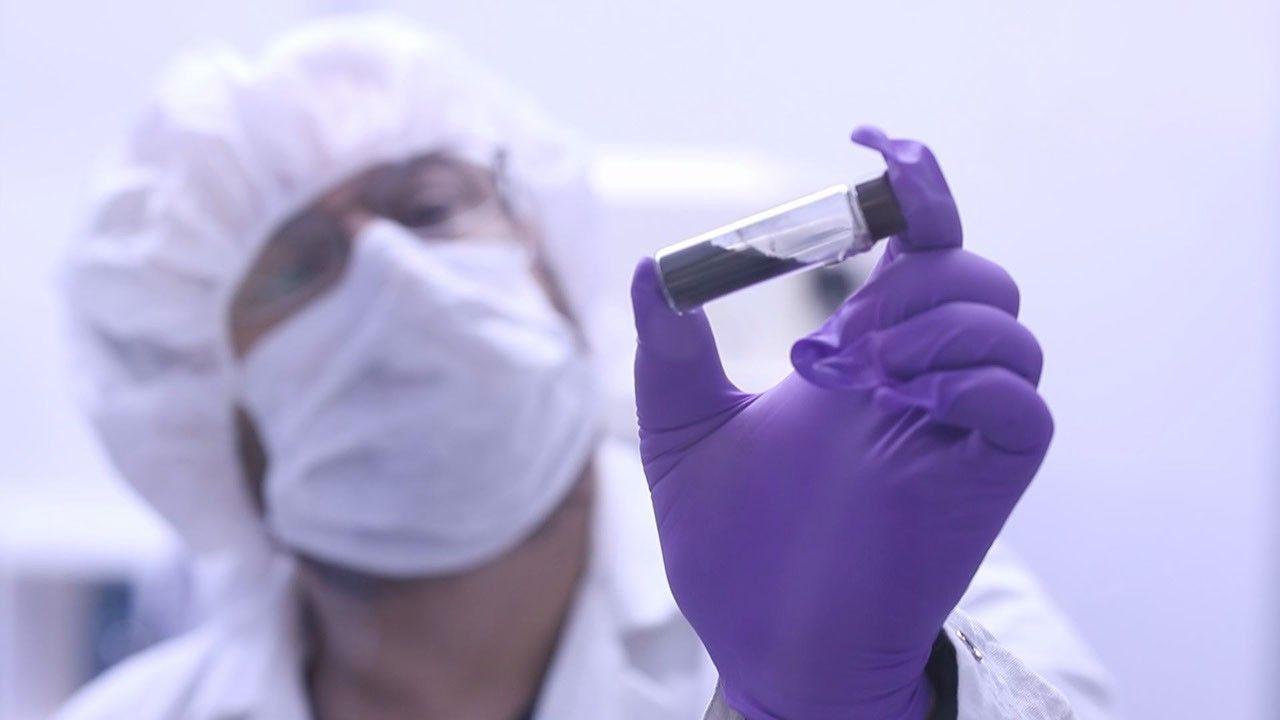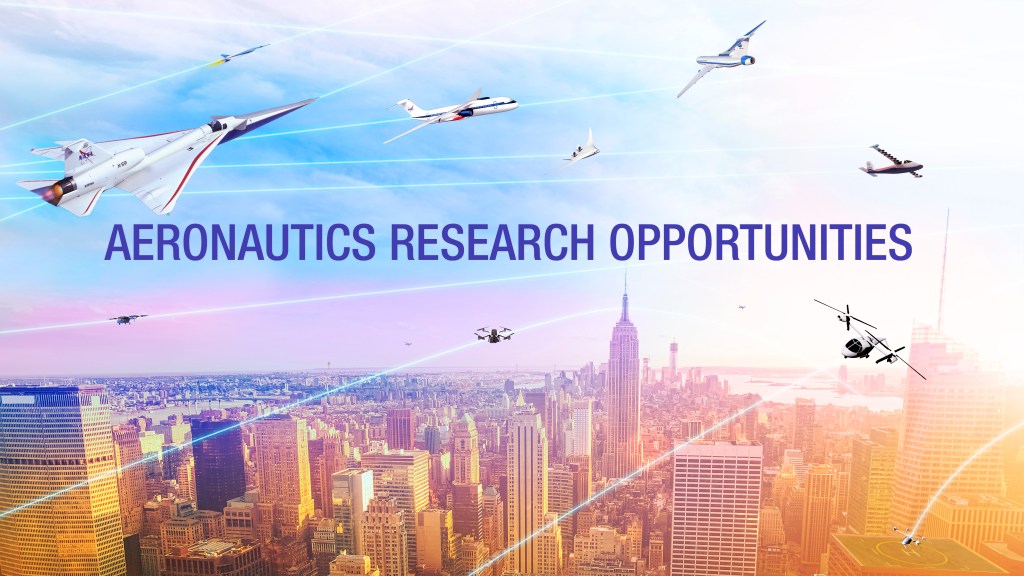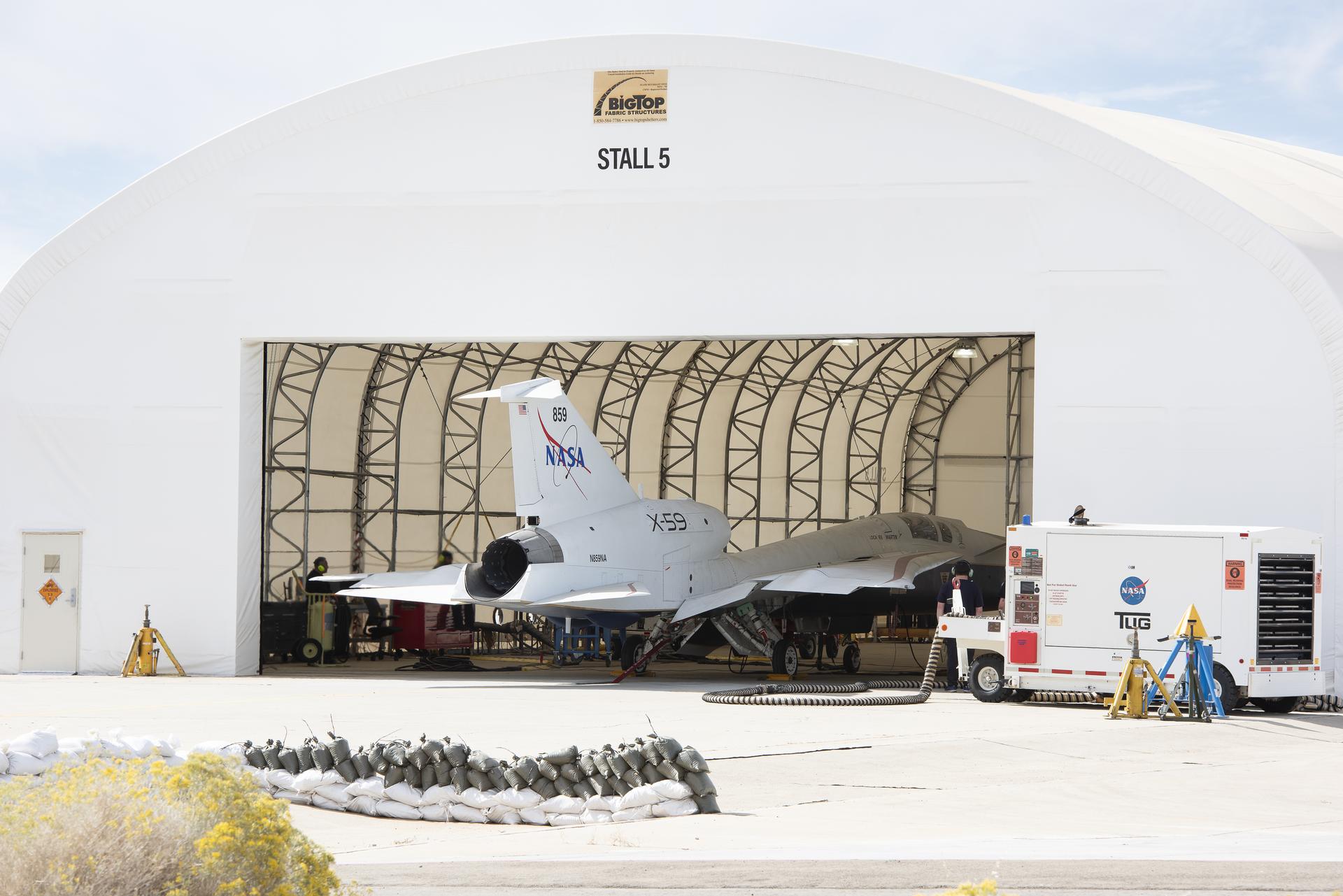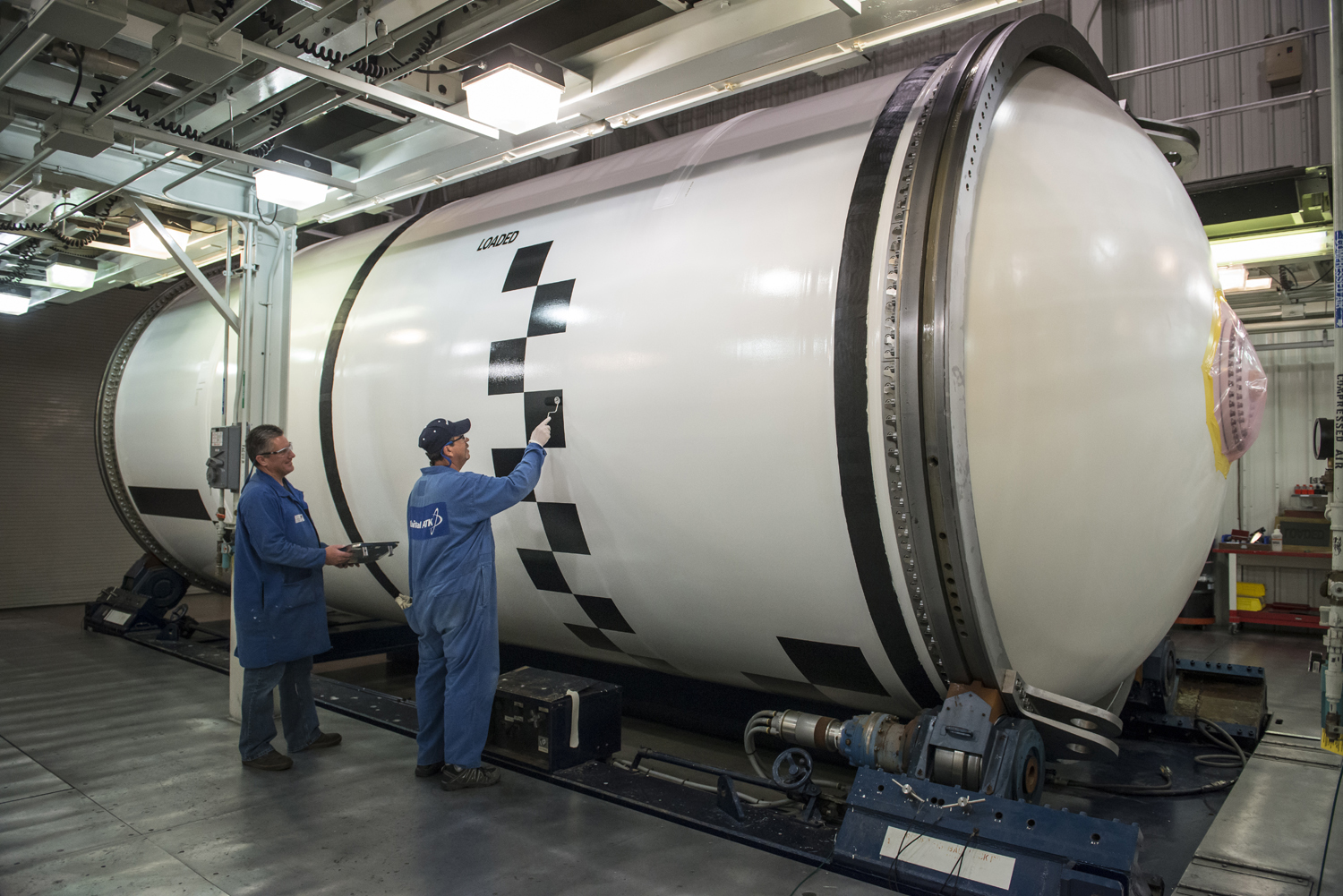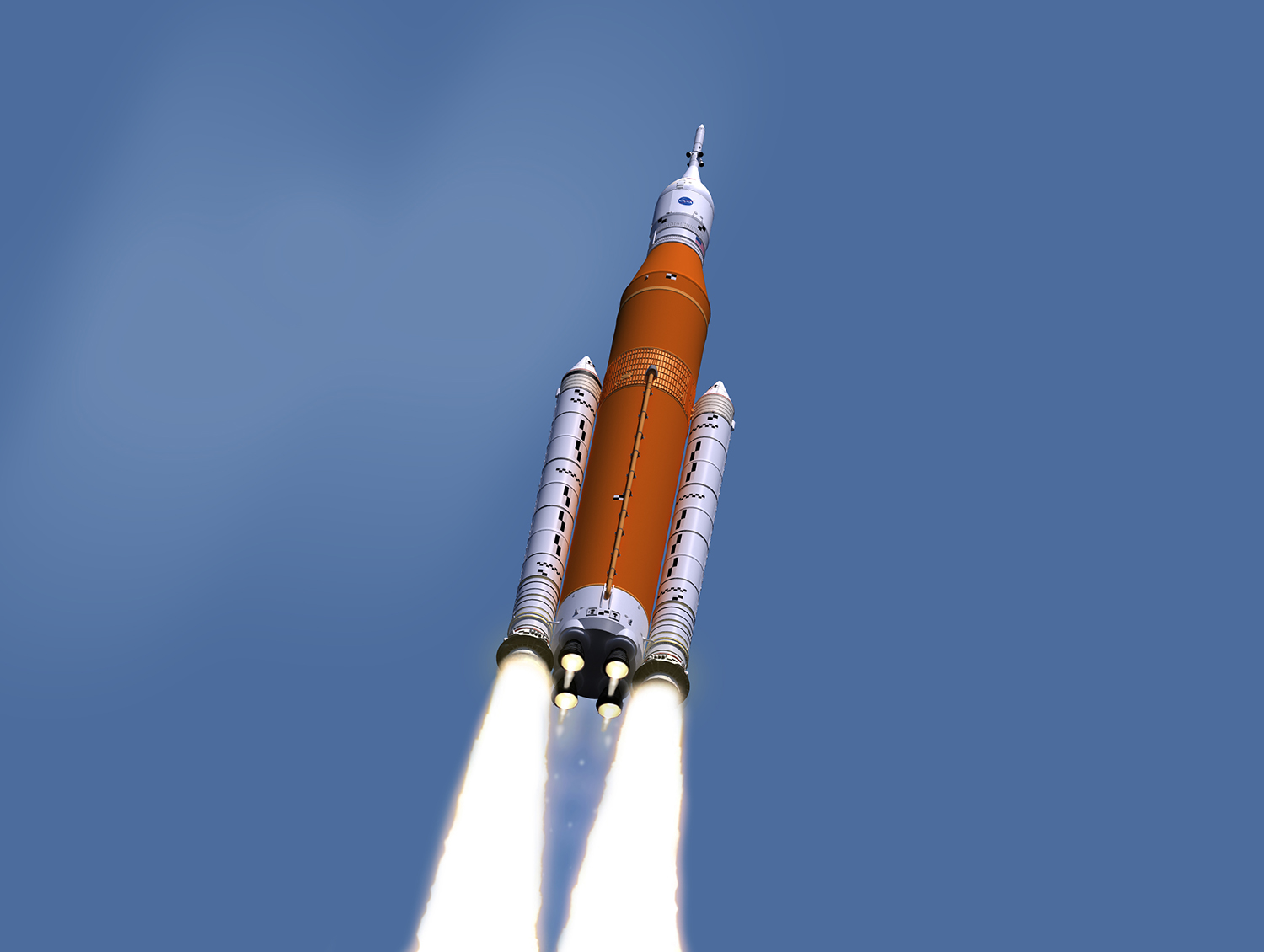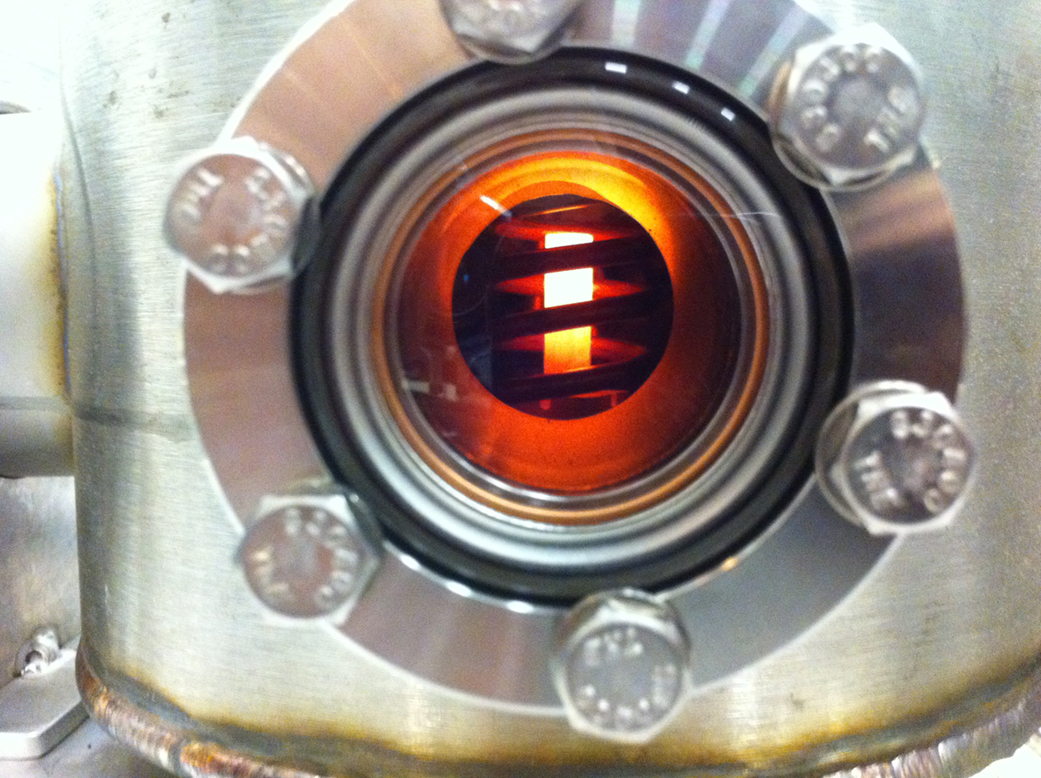In This Week’s Star
- Space Launch System Solid Rocket Boosters ‘on Target’ for First Flight
- NASA Guide Outlines Deep Space Rocket’s Unprecedented Capabilities
- Marshall’s Electrostatic Levitation Facility Defies Gravity for Science
- NASA Contracts with BWXT Nuclear Energy to Advance Nuclear Thermal Propulsion Technology
- Joint NASA-Brazil SPORT CubeSat Mission Will Unlock Complex Equatorial Phenomena, Lay Groundwork for Better Space Weather Prediction
- U.S. Rep. Chuck Fleischmann Visits Marshall to Spark Collaboration with Tennessee Government and Businesses
- Marshall Summer Interns Highlight Work Experiences During Poster Exposition
- This Week in NASA History: STS-118 Delivers Third Starboard Truss to ISS – August 8, 2007
- Obituaries
Space Launch System Solid Rocket Boosters ‘on Target’ for First Flight
Production of the five-segment powerhouse motors for NASA’s Space Launch System solid rocket boosters is on target at prime contractor Orbital ATK’s facilities in Utah, with 10 motor segments cast with propellant and four of those segments complete.
Following propellant casting, the finished segments were evaluated using non-destructive techniques — such as X-ray scanners — to ensure they met quality standards, and the exterior cases were painted white with black-and-white photogrammetric markings. All motor segments will ultimately be shipped to NASA’s Kennedy Space Center, where they will be integrated with forward and aft booster structures and then with the SLS core stage.
The markings on the outside of the complete boosters look like black-and-white checkerboards and serve as “targets” for cameras located in strategic locations on and around the vehicle to be used for photogrammetry — the science of using photography to help measure distances between objects.
Black-and-white photogrammetric targets will also appear on the SLS core stage, the interim cryogenic propulsion stage and the Orion stage adapter. On Orion, NASA’s deep-space exploration spacecraft, photogrammetric markings will appear on the spacecraft adapter. The mobile launcher will also have photogrammetric markings. In addition, certain elements of the integrated stack, like the launch vehicle stage adapter, have photogrammetric markings on the interior rather than the exterior.
Cameras will be located on Orion, on the rocket’s core stage, on the interior of the launch vehicle stage adapter, on the ground and on the mobile launcher. The cameras will be able to more easily track the vehicle’s position in space by fixing on the black-and-white checkerboard targets. NASA’s photogrammetry analysts will then use software to process the images from the cameras to measure distances, such as between the boosters and the core stage after those elements separate. Engineers are also interested in measuring the booster nozzles’ clearance from the mobile launcher and the entire vehicle’s clearance from the mobile launch tower shortly after liftoff.
One area that engineers are particularly interested in is how the SLS solid rocket boosters — the largest ever manufactured for flight — will separate from the core stage. “Booster separation is influenced by several factors — their length, the configuration of the separation motors and the timing of separation,” explained Alex Priskos, SLS systems engineering and integration manager, at NASA’s Marshall Space Flight Center. “The longer separation is delayed, the greater the clearance will be. However, waiting longer adversely impacts performance. Our job is to balance these factors.”
Engineers designed SLS using state-of-the-art 3D software models and analysis, explained Beth St. Peter, SLS imagery integration lead. “As accurate as those models are, photogrammetry will provide real-life ‘truth data’ on separation events and other key points. And for the first flight of SLS, gathering this real-world data on how the vehicle performs compared to the models is crucial.”
Although NASA has used photogrammetry since the days of the Saturn moon rockets and the space shuttle, use of the technology has come a long way, St. Peter said, primarily due to advances in being able to place digital imagery systems on launch vehicles.
SLS and Orion will incorporate different types of checkerboard patterns, or photogrammetric targets, which will be used for different types of measurements, noted David Melendrez, Orion’s lead for imagery integration at NASA’s Johnson Space Center. “The big squares will be used to measure general vehicle motion and ground clearances. Smaller checkerboards and elongated markings will be used to measure more complicated three-dimensional motions of the boosters relative to the core stage during their separation, about two minutes into the spaceflight.”
On some parts of the rocket, smaller circular markings will help the cameras and photogrammetric software measure separation events, like Orion’s separation from the interim cryogenic propulsion stage. “Some of these smaller markings will also have retro-reflective centers to help improve our ability to see them under the dark conditions we’re likely to encounter on-orbit,” Melendrez said.
In the final design, the photogrammetric checkerboards will replace the orange and gray stripes that had been previously considered. “Designing and building these deep-space exploration systems is an evolutionary process,” Priskos said. “In the beginning, you define a mission and a basic architecture to take you where you want to go. The details might be a little fuzzy at first, but gradually, like a camera zooming in closer and closer, those details are revealed. This is where we are with SLS and Orion.”
On launch day — and during the duration of the first mission — it won’t just be the engineers on the ground who see the imagery from the cameras located at various spots on the vehicle and ground. “Some cameras will record imagery onboard SLS and Orion and transmit later. But there will also be some live downlinked imagery from these cameras on launch day,” Melendrez said. “People watching at home will be able to see some of this imagery live on NASA TV.”
With the application of black-and-white photogrammetric targets on the solid rocket boosters, NASA’s new capability for exploring deep space is becoming clearer — and closer — all the time.
NASA Guide Outlines Deep Space Rocket’s Unprecedented Capabilities
By David Hitt
NASA’s Space Launch System provides America with a unique capability to launch more than double what any current vehicle can launch today. The rocket can send humans on exploration missions, carry large cargos, such as habitats, and still have room for exploration supplies and scientific payloads, both large and small. The vehicle’s large payload capacity and unrivaled power allow it to send missions to deep space and reach distant destinations faster than before.
A new SLS Mission Planners Guide provides an in-depth overview of different possible rocket configurations, capabilities and technical specifications. It supplies mission architects and spacecraft designers with data needed to understand how the rocket offers an unprecedented way to launch payloads — from small satellites to exploration systems complementing the Orion crew spacecraft. The guide explains how SLS can launch a robotic science mission to the moons of Jupiter years more quickly, carry a much larger space probe than is possible today, deliver larger payloads or deliver small secondary payloads along for a ride with the Orion crew spacecraft.
“The SLS Mission Planners Guide is our tool for helping spacecraft developers think outside the constraints of smaller, less powerful rockets,” said Steve Creech, manager for SLS’s Spacecraft/Payload Integration and Evolution at NASA’s Marshall Space Flight Center. “SLS offers the option of launching with a much larger payload fairing instead of Orion, allowing it to able carry payloads five times the volume of any contemporary rocket, and weighing about four times as much as what the space shuttle could carry.”
The first flight of SLS will launch an uncrewed Orion spacecraft and will also transport 13 smallsats for international, government and academic researchers. These satellites, about the size of a large cereal box, will conduct a variety of innovative research — from studying the effects of deep-space radiation on lifeforms to conducting solar observations to deploying a solar sail on a mission to rendezvous with an asteroid. On the second SLS flight, the evolved Block 1B configuration of SLS will carry a crewed Orion craft, large co-manifested payloads and larger smallsats on deep-space missions.
The SLS lifts off with more that 8 million pounds of thrust, and evolved configurations of the SLS can send more than 105 metric tons (231,485 pounds) to low-Earth orbit and send up to 30 metric tons (66,138 pounds) to an orbit beyond the moon.
SLS Block IB features a powerful Exploration Upper Stage and a Universal Stage Adapter that is 32.4 feet tall and measures 27.6 feet in diameter at its largest point. SLS’s Universal Stage Adapter and payload adapters will provide foundational launch capability for missions in the vicinity of the moon as NASA builds a flexible, reusable and sustainable infrastructure that will last multiple decades and support missions of increasing complexity. The Universal Stage Adapter can carry the same volume of payload that filled the space shuttle payload bay, and the fairing that shrouds SLS payloads accommodates twice the volume of the space shuttle. Fairings on later missions can be as large as 27.6 feet (8.4 meters), providing three times more volume than the space shuttle.
The SLS Exploration Upper Stage also provides environmental control to payloads during ground operations, launch and ascent, while also accommodating the electrical and communication paths between the upper stage and Orion. Much as the space shuttle had a payload bay that allowed it to carry satellites, space telescopes and space station modules into orbit with the astronauts, the Universal Stage Adapter — together with a payload adapter inside it — function essentially like a “payload bay” for the rocket. As with the shuttle, astronauts launch into space atop the vehicle with a large area for cargo beneath them — larger than the payload volumes currently available on any other rocket.
For example, the Bigelow Expandable Activity Module — an expandable habitat technology recently deployed for testing on the International Space Station — weighs 3,000 pounds, so SLS Block 1B could deliver 20 of these in one launch. SLS Block 1B could transport one 32,000-pound space station Destiny module and still carry almost another 30,000 pounds of scientific research equipment, rovers or other supplies beyond the moon. Parts for the planned SLS Deep Space Gateway could be launched with the Orion spacecraft into lunar orbit in modules. The modules will be assembled in the space around the moon in a manner similar to the construction of the International Space Station, but with fewer components and 1,000 times farther from Earth.
“With SLS and Orion, NASA is launching the ‘next giant leap’ for human exploration of space, but we’re also beginning to see the leaps forward this new capability will enable in our understanding of our solar system and universe,” Creech said. “We’re excited to work with the scientific community, and our industry, academia and international partners to create that future.”
To download a copy of the guide, click here.
Marshall’s Electrostatic Levitation Facility Defies Gravity for Science
By Bill Hubscher
It’s no secret that NASA’s Marshall Space Flight Center has world-class facilities to build vehicles for space exploration or make scientific discoveries about our planet. In fact, scientists from around the world frequently visit Huntsville to use them.
One of these facilities is drawing scientists to perform test-runs of various experiments safely on the ground before sending them to orbit for study on the International Space Station.
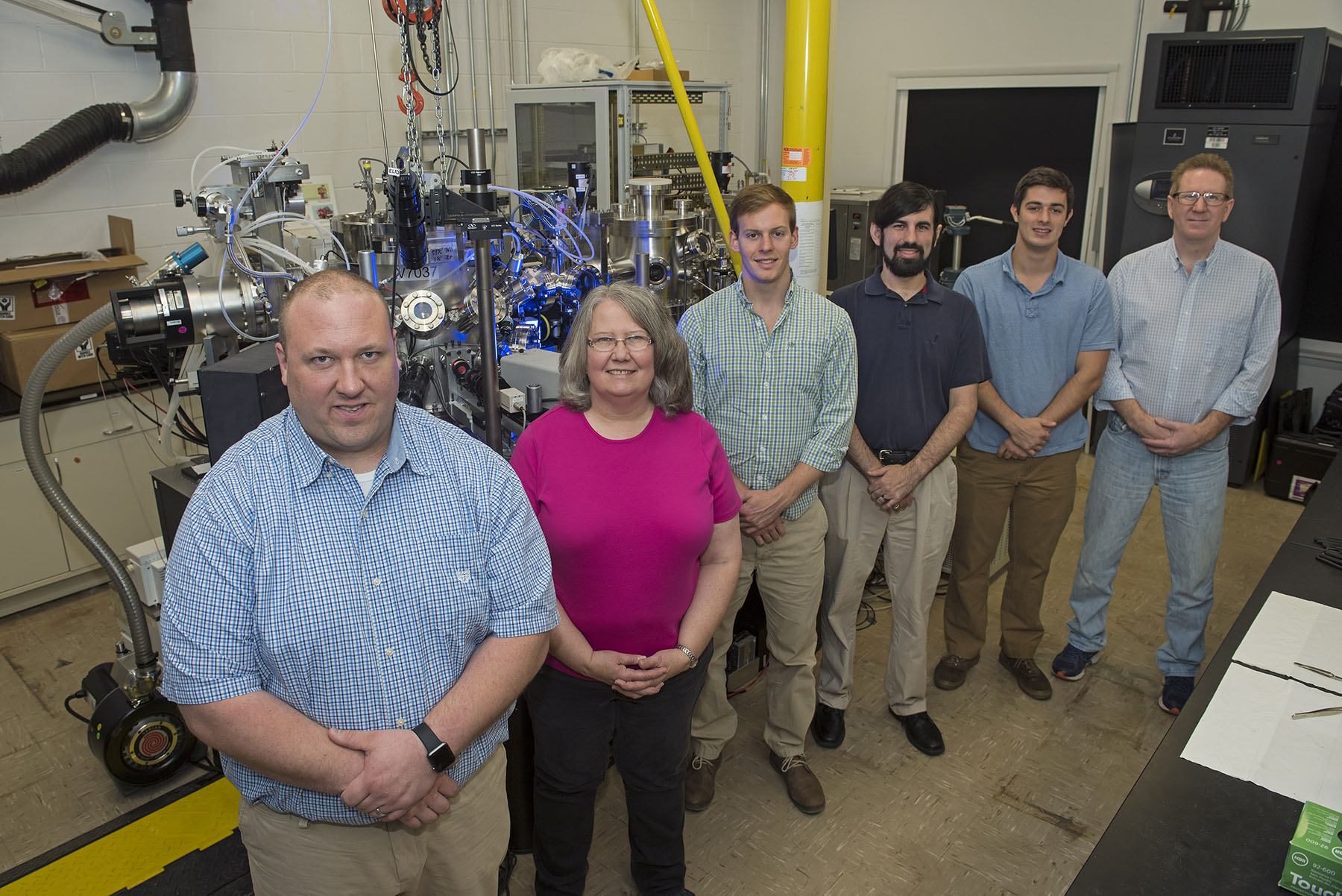
Microgravity helps scientists collect data on the properties of materials that are sensitive to gravity-driven phenomena such as fluid flows or sedimentation. Experiments conducted on the station will provide important thermophysical information of metals, glasses, metal oxides and ceramics.
The Electrostatic Levitation Laboratory at Marshall simulates microgravity by using a controlled power source to “float” a sample of any given material. The samples are levitated in a vacuum or pressurized environment to avoid contamination and to allow for accurate and precise measurements. Once the tiny sample — about 2 millimeters across — is floating, Marshall engineers shoot them with lasers.
“Earth’s gravity limits the size of our samples,” said Michael SanSoucie, a materials engineer with Marshall’s Materials & Processes Laboratory. “Normally, you would heat metal in a crucible or bowl. However, the energy transfer between the container and the sample could provide faulty data. This containerless method of heating the material makes it easier to work with and gives us more accurate observations and measurements. It also allows us to make unique types of measurements.”
A group from the University of Florida in Gainesville recently visited this lab to test an alloy of titanium, zirconium and nickel to measure its density, surface tension and viscosity as a liquid metal. A sample of the alloy was bathed in ultraviolet light, causing it to eject electrons and become positively charged. The levitator then generated an electrostatic field using copper electrodes and high-voltage power amplifiers to counteract gravity and hold the sample in position.
“Using this method, we can work with any kind of sample including glass or ceramics, not just metal,” said SanSoucie.
Once the sample is held in a kind of stasis, the Marshall engineers fire lasers at it to heat it and change it from solid to liquid — observing all points in between — to measure surface tension and thermal energy. These measurements will help develop advanced materials for use in manufacturing, including building parts for future spacecraft or planetary habitats.
The goal is to test the same materials in orbit where gravity and convection will not have an effect and look for flaws that are difficult to see in a terrestrial environment under the influence of gravity.
“You want to do as much research and study as much as you can on the ground before sending it to space,” said Kevin Ward, one of the chemical engineering students from the University of Florida using the levitator. “We can compare the data gathered from here at Marshall to the information captured on the space station for this and other materials, looking for strengths and weaknesses.”
Over the course of the week, the student scientists and Marshall personnel took measurements of more than 100 heatings and coolings of the alloy, observing the flow of the liquid phase of the metal for viscosity or density.
There is a version of this technology on the space station, but the electrostatic levitator at Marshall provides important baseline information about the material to be added to an important database. NASA and the National Institute of Standards and Technology recently signed a Memorandum of Understanding to foster collaboration among NASA’s microgravity materials science program, the NIST Material Measurement Laboratory and the multi-agency Materials Genome Initiative. MaterialsLab will share data from past and present space station investigations through NASA’s Physical Science Informatics system — a resource for processing and sorting data from physical science experiments performed aboard the orbiting laboratory. The goal is to promote an open access approach to scientific data analysis and potentially guide hundreds of new, space-station-based scientific investigations.
Groups from the University of Massachusetts in Amherst; Tufts University in Medford, Massachusetts; and Materials Development Inc. in Arlington Heights, Illinois, are all scheduled to visit Marshall in the coming months to test more alloys in the electrostatic levitator.
In the meantime, Marshall engineers and scientists are learning more about the materials to make it easier to cast parts or weld stronger pieces of the spacecraft that will take us to deep space.
Hubscher, an ASRC Federal/Analytical Services employee, supports the Office of Strategic Analysis & Communications.
NASA Contracts with BWXT Nuclear Energy to Advance Nuclear Thermal Propulsion Technology
By Rick Smith
As NASA pursues innovative, cost-effective propulsion solutions to forge new paths into the solar system, researchers at NASA’s Marshall Space Flight Center say nuclear thermal propulsion technologies are more promising than ever, and have contracted with BWXT Nuclear Energy Inc. of Lynchburg, Virginia, to further advance and refine those concepts.
Part of NASA’s Game Changing Development Program, the Nuclear Thermal Propulsion project could indeed significantly change space travel — largely due to its ability to accelerate a large amount of propellant out of the back of a rocket at very high speeds, resulting in a highly efficient, high-thrust engine. In comparison, a nuclear thermal rocket has double the propulsion efficiency of the space shuttle main engine, one of the hardest-working standard chemical engines of the past 40 years.
That capability makes nuclear thermal propulsion ideal for delivering large, automated payloads to distant worlds, researchers say.
“As we push out into the solar system, nuclear propulsion may offer the only truly viable technology option to extend human reach to the surface of Mars and to worlds beyond,” said Sonny Mitchell, Nuclear Thermal Propulsion project manager at Marshall. “We’re excited to be working on technologies that could open up deep space for human exploration.”
A nuclear thermal propulsion system can cut the voyage time to Mars from six months to four and safely deliver human explorers by reducing their exposure to radiation. That also could reduce the vehicle mass, enabling deep space missions to haul more payload.
Given its experience in developing and delivering nuclear fuels for the U.S. Navy, BWXT will aid in the design and testing of a promising, low-enriched uranium-based nuclear thermal engine concept and “Cermet” — ceramic metallic — fuel element technology. During this three-year, $18.8-million contract, the company will manufacture and test prototype fuel elements and also help NASA properly address and resolve nuclear licensing and regulatory requirements. BWXT will aid NASA in refining the feasibility and affordability of developing a nuclear thermal propulsion engine, delivering the technical and programmatic data needed to determine how to implement this promising technology in years to come.
The company’s new contract is expected to run through Sept. 30, 2019.
Nuclear-powered rocket concepts are not new. The United States conducted studies and significant ground tests from 1955 to 1972 to determine the viability of such systems, but ceased testing when plans for a crewed Mars mission were deferred. Since then, nuclear thermal propulsion has been revisited several times in conceptual mission studies and technology feasibility projects. Thanks to renewed interest in exploring the Red Planet in recent decades, NASA has begun new studies of nuclear thermal propulsion, recognizing its potential value for exploration of Mars and beyond.
In late September, the Nuclear Thermal Propulsion project will determine the feasibility of using low-enriched uranium fuel. The project then will spend a year testing and refining its ability to manufacture the necessary Cermet fuel elements. Testing of full-length fuel rods will be conducted using a unique Marshall test facility.
NASA’s Game Changing Development Program, which manages the Nuclear Thermal Propulsion project, is part of the agency’s Space Technology Mission Directorate.
Smith, an ASRC Federal/Analytical Services employee, supports the Office of Strategic Analysis & Communications.
Joint NASA-Brazil SPORT CubeSat Mission Will Unlock Complex Equatorial Phenomena, Lay Groundwork for Better Space Weather Prediction
By Rick Smith
NASA and a team of Brazilian researchers have announced a joint CubeSat mission to study phenomena in Earth’s upper atmosphere — a region of charged particles called the ionosphere — capable of disrupting communications and navigation systems on the ground and potentially impacting satellites and human explorers in space.
Two phenomena in the ionosphere — equatorial plasma bubbles and scintillation — have impacted radio communication systems, satellite technologies and global positioning system signals for decades, according to Jim Spann, chief scientist for the Science and Technology Directorate at NASA’s Marshall Space Flight Center. Equatorial plasma bubbles are regions of comparatively low density which may elongate into towering plumes during high-intensity periods. Scintillation is a unique type of atmospheric fluctuation that can interrupt radio frequencies, much like the “twinkling” effect seen in starlight when optical frequencies are disrupted.
The Scintillation Prediction Observations Research Task mission, funded by NASA’s Science Mission Directorate, will observe these peculiar structures to learn what causes them, how to predict their behavior and how to mitigate their effects.
The joint U.S.-Brazilian team, led by Spann as principal investigator, will design and launch SPORT as a CubeSat — a compact satellite about the size of two loaves of bread. It will be launched in 2019 to an Earth orbit approximately 217-248 miles high. Its operational phase is expected to last at least a year.
While in orbit, the CubeSat research will help combat a phenomenon called the South Atlantic Anomaly or the South American Magnetic Anomaly, wherein space radiation dips close to Earth, negatively impacting Brazil’s busy airports. “Our country is interested in refining GPS signal processing, making takeoffs and landings safer and more precise,” said Otavio Durão, SPORT project manager at Instituto Nacional de Pesquisas Espaciais in São Jose dos Campos, Brazil. “Because so many international flights come to and through Brazil, this should be a matter of concern for all countries.”
Brazil’s agricultural industry also is concerned about the anomaly’s effects on GPS, according to Durão’s colleague Luís Loures, the SPORT spacecraft manager at the Instituto Tecnológico da Aeronáutica in São Jose dos Campos. “Our agribusiness is always trying to increase crop productivity,” Loures said. “One way to accomplish this is by using automated tools. Being able to precisely position those automated tractors and field sprayers, without disruption from solar phenomena, is crucial.”
“As society becomes more dependent every day on space-based technology — cell phones, self-driving cars, secure military communications — it’s critically important we first understand the environment in which our technology resides, then learn how to operate through and preserve it from potentially disruptive or damaging interference,” Spann said.
Building on decades of previous ground-based studies, SPORT will help researchers determine what’s happening in the ionosphere to stir up the bubbles, why they form along the equator and what causes them to appear at night. Plasma bubbles and scintillation are global equatorial and mid-latitude phenomena, made worse by the South American Magnetic Anomaly.
“Many of the discoveries to date have been confined to a limited number of longitudinal sectors,” Spann said. “SPORT will make a systematic study of the ionosphere at all longitudes around the planet, documenting the conditions that trigger formation of the bubbles, with particular focus on the South American sector.”
The team is confident its findings will enable researchers to use physics-based models to determine the physics of plasma bubble triggers, and thus identify the resulting scintillation of radio signals that propagate throughout the turbulent region.
SPORT is part of NASA’s Heliophysics Technology and Instrument Development for Science program. NASA’s heliophysics mission includes research into the effects of the sun on Earth, its atmosphere and the planets of our solar system.
Read the complete NASA news release detailing the SPORT mission here.
Smith, an ASRC Federal/Analytical Services employee, supports the Office of Strategic Analysis & Communications.
U.S. Rep. Chuck Fleischmann Visits Marshall to Spark Collaboration with Tennessee Government and Businesses
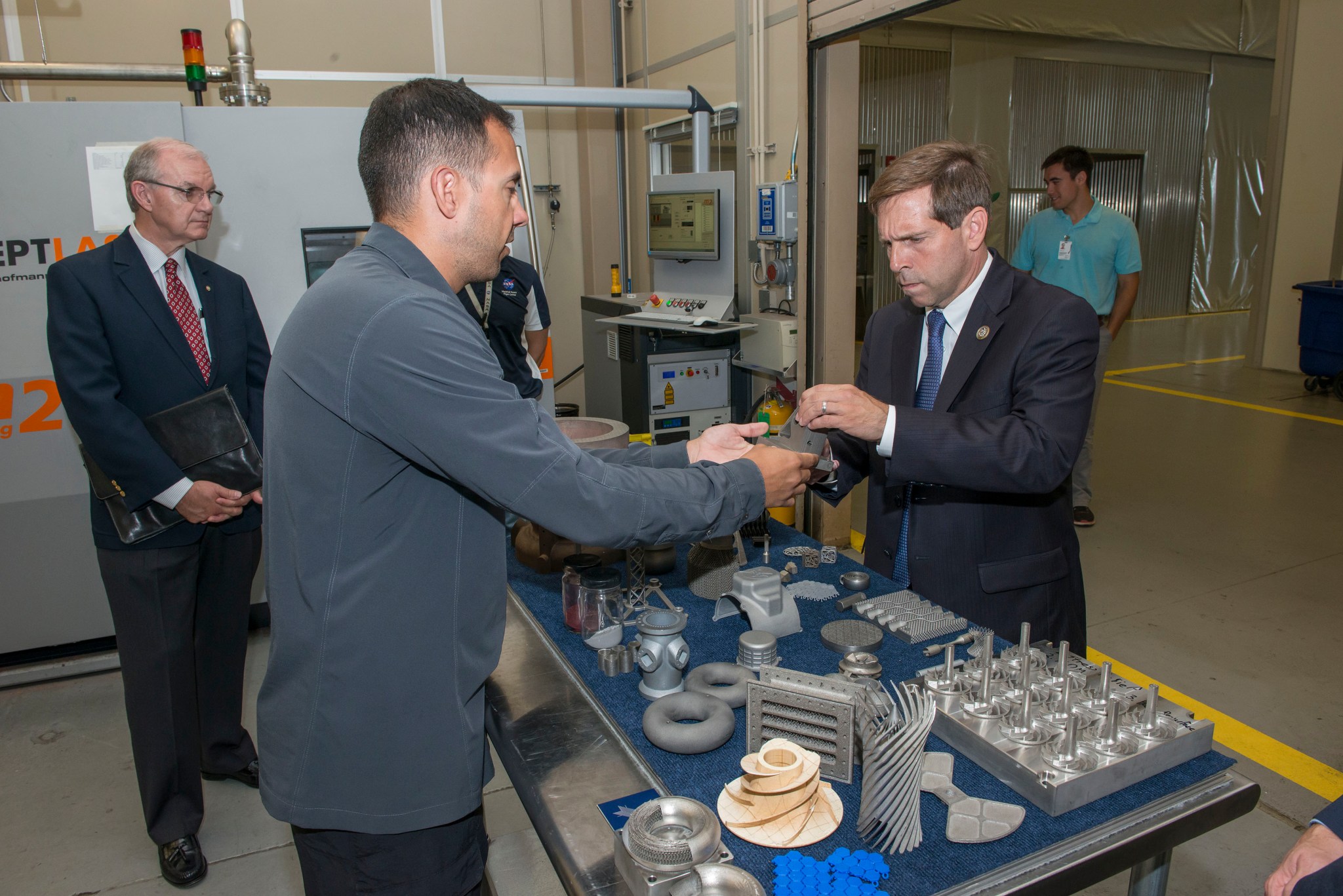
U.S. Rep. Chuck Fleischmann, right, who represents Tennessee’s 3rd Congressional District, met with engineers and managers of NASA’s Marshall Space Flight Center Materials & Processes department Aug. 1 to identify ways that Marshall could collaborate with Tennessee-based government laboratories and businesses. Fleischmann was briefed on the additive manufacturing capabilities at Marshall and NASA’s overall exploration needs. The congressman also took time to meet the entire engineering and intern team supporting his visit. (NASA/MSFC)
Marshall Summer Interns Highlight Work Experiences During Poster Exposition
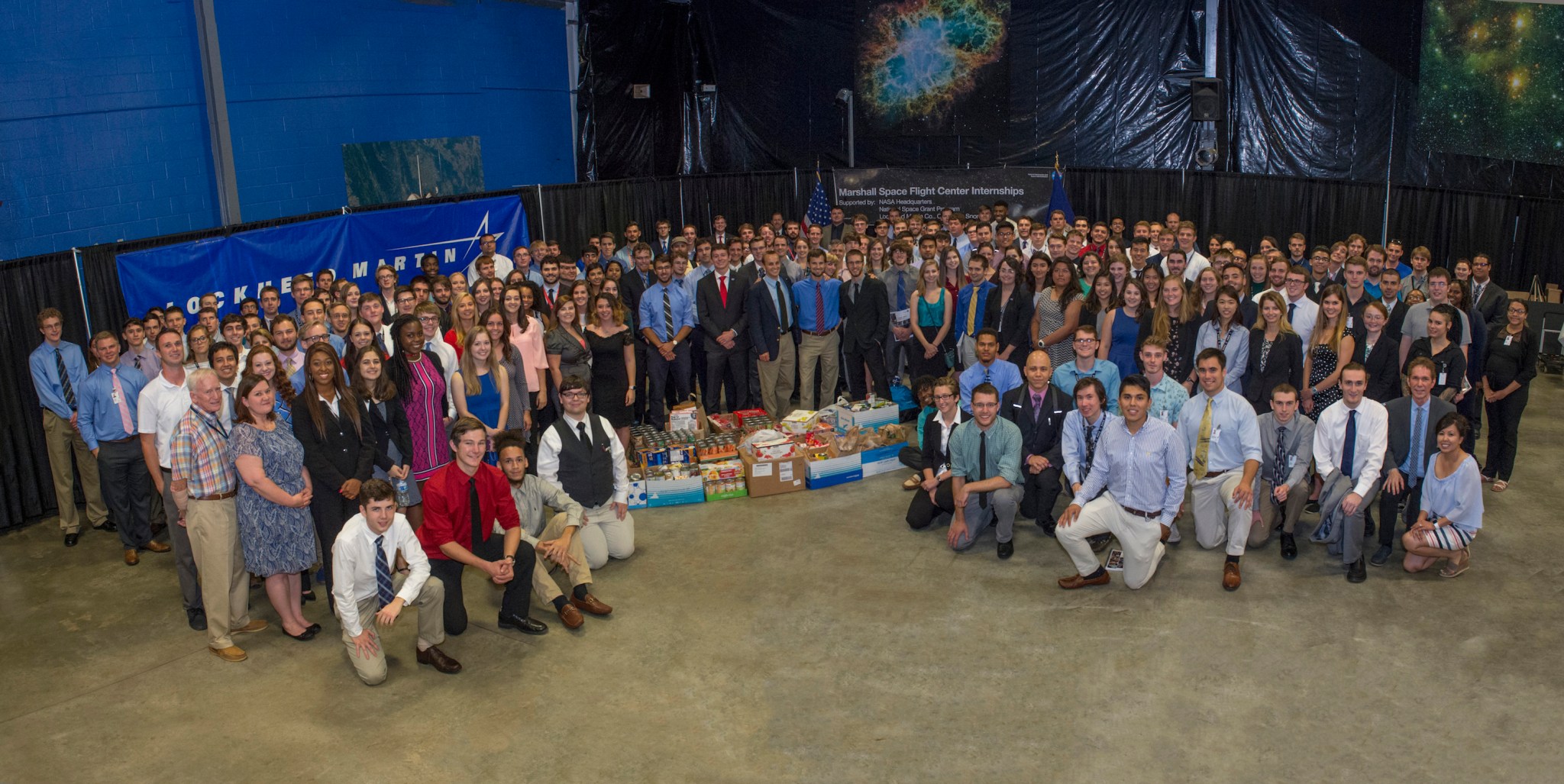
On Aug. 2, almost 200 interns at NASA’s Marshall Space Flight Center participated in the 2017 Poster Exposition and Awards Ceremony. The annual event recognizes Marshall interns’ achievements in NASA fields of study, as well as the completion of their summer internships. Marshall team members viewed student poster designs, talked with the interns to learn more about their work experiences and contributed non-perishable items as votes toward the interns’ posters. As a result, more than 1,000 non-perishable items were donated to the Feds Feed Families program. (NASA/MSFC/Emmett Given)
This Week in NASA History: STS-118 Delivers Third Starboard Truss to ISS – August 8, 2007
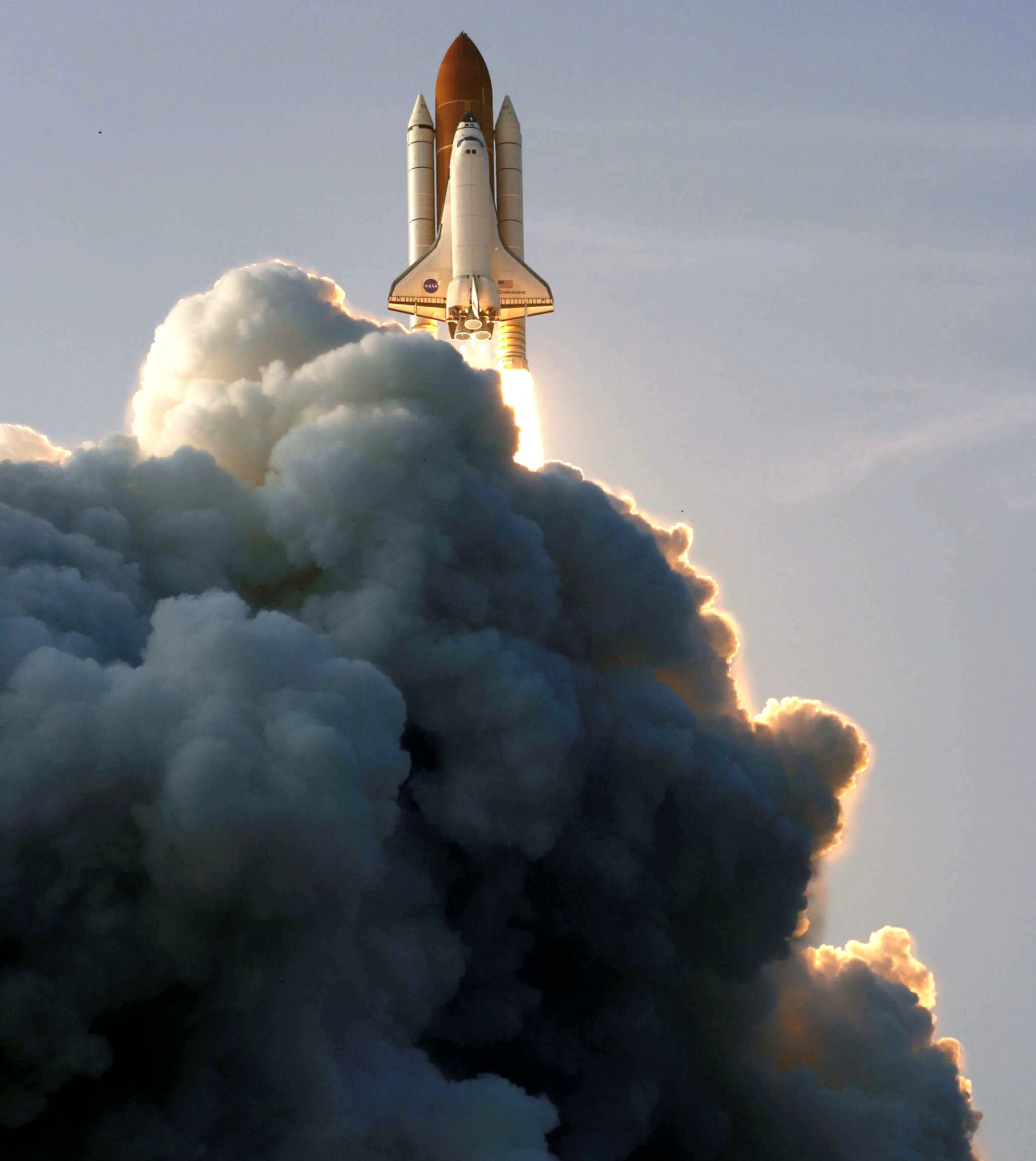
This week in 2007, space shuttle Endeavour and STS-118 launched from Kennedy Space Center to complete installation of the third starboard S5 truss segment to the International Space Station. Today, the Payload Operations Integration Center at Marshall serves as “science central” for the International Space Station, working 24/7, 365 days a year in support of the orbiting laboratory’s scientific experiments. The NASA History Program is responsible for generating, disseminating, and preserving NASA’s remarkable history and providing a comprehensive understanding of the institutional, cultural, social, political, economic, technological, and scientific aspects of NASA’s activities in aeronautics and space. For more pictures like this one and to connect to NASA’s history, visit the Marshall History Program’s webpage. (NASA)
Obituaries
Loyce E. Webster, 85, of Gurley, Alabama, died July 31. He retired from the Marshall Center in 1987 as a model maker. He is survived by his wife, Dortha P. Webster.

